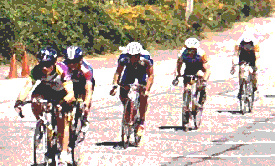Important Ed Tech Book Reviews
Just in Time Technology
|
|
| Vol 10|No 3|November/December|2000 | |
When it comes to networking schools and classrooms, leaders tend to rush things. Just as folk wisdom argues that "Haste makes waste," research on change in schools warns against riding change mobiles through avalanche territory (Fullan, 1991). Even though the shortest distance is usually a straight line, most road and railway builders know better than to head straight up a mountain without providing plenty of curves. They rely on switchbacks to keep the angle of ascent reasonable. They know engines have their limits. Schools should follow this example. They should make the strategic pacing of change a priority if they hope to see a real (and beneficial) shift in classroom practice Switchbacks Schools should provide switchbacks, rest stops and plateaus as they network. They should also allow for different starting times. unwired ----> wired ----> wireless In the past few years we have asked teachers and students to leave behind the security of unwired classrooms in order to enjoy wired classrooms and global networks. And now we are asking them to adjust once again — this time to wireless classrooms! All the while, new state standards and tests provide a constant backdrop of storm clouds and thunder that make it hard for teachers to take risks or to embrace new strategies (Becker, 1999). A frenzied pace of change can prove disheartening and disabling. It may create the appearance of change without any value being added. It might even stall growth as members of the community cling to the familiar in the face of threats and chaos. A single coyote kicks up a cloud of dust digging for a long lost soup bone. From far away, the cloud creates the appearance of a speeding roadrunner as the wind sweeps dust along the highway. Sometimes schools create the mere appearance of movement. But careful planning can provide the calm, the shelter, the resources and the time so teachers will make substantial, lasting progress. Virtual change is a publicity stunt. Real change is harder to realize but infinitely more valuable. Traits of Managed Change
Sprinkling computers across classrooms is easy. Fostering daily, routine and robust use tied to curriculum standards is quite another matter. Districts should provide standards-based professional development that showing teachers how to change student performance (McKenzie, 1999). Networked computers are great for exploration and investigations, for problem-solving and engaged learning - activities that could pay off handsomely on demanding state tests and standards if the teachers are shown the connection between research, inferential reasoning and the state standards (McKenzie, 2000). Wireless computers allow rapid movement of computers where they are most welcome and will do the most good. Teachers require "critical mass" to make profitable, intense, daily use of networked computers. In most cases, they are better off with 15 computers for one week every two months than 2-3 computers all year. Premature installation creates few converts and fails to promote robust use. First we design learning experiences worth doing. Then we provide the equipment. No carts before the horses! We make it clear that all will take the journey, but we provide latitude and choice when it comes to the timing and the nature of each professional journey of change. A sense of choice is directly associated with buy in and full participation. When teachers can match learning to their individual styles and preferences, they are more apt to travel from the tried and true. We will not see robust use unless we have taken the time to demonstrate the worth of the new tools and have convinced teachers that new technologies can make a real contribution. Announcing change without courtship often results in resistance rather than progress. We set a reasonable time limit, provide generous support to learn new strategies, build clear expectations into curriculum guides and hold all teachers accountable to offer what the guides prescribe. We remove barriers, eliminate excuses and make the new opportunities enticing. Those in charge of the implementation ask lots of questions and take the time to listen to those who must make the program work. "How is it going? How can I help? What needs changing?"
References Becker, Henry. 1999. "Internet Use by Teachers" Web site at University of California Irvine http://www.crito.uci.edu/TLC/FINDINGS/internet-use/startpage.htm) Fullan, Michael. 1991. The New Meaning of Educational Change. Teachers College Press. McKenzie, Jamie. 1999. How Teachers Learn Technology Best. FNO Press. http://fnopress.com/books.html McKenzie, Jamie. 2000. Beyond Technology: Questioning, Research and the Information Literate School. FNO Press. http://fnopress.com/books.html |
Back to November CoverCredits: The photographs were shot by Jamie McKenzie. |
 From Now On
From Now On